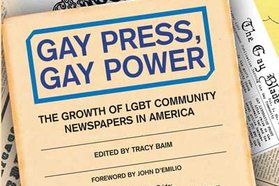Tracy Baim is optimistic about the role that the gay press continues to play in the LGBT community, and she’s in a position to know.
With almost 30 years in LGBT journalism under her belt, Baim has firsthand knowledge of the subject. She’s gone from doing hand-set type to becoming the publisher and executive editor of the Windy City Media Group, which publishes Chicago’s gay weekly, the Windy City Times, as well as other print and online publications.
Baim will share some of that knowledge when she visits Philadelphia Aug. 20 to discuss her new book, “Gay Press, Gay Power: The Growth of LGBT Community Newspapers in America.” The talk begins 5:30 p.m. at Giovanni’s Room, 345 S. 12th St. Baim will be joined by Mark Segal, publisher of PGN, one of 10 longstanding regional LGBT newspapers singled out for discussion in the book.
The book, a 2013 Lambda Literary Award finalist, offers a wide-ranging look at LGBT media. Baim got the idea for the book in 2011 and enlisted numerous collaborators to help write and edit it, including historian John D’Emilio and columnist St. Sukie de la Croix. More than 450 pages long, there is ample room to discuss broad topics, such as the mainstream media’s treatment of gays and the rise of an alternative LGBT media. But that still leaves plenty of space to highlight notable periodicals such as the Washington Blade and pioneering journalists, including Perry Brass and Karla Jay.
According to Baim, “Gay Press, Gay Power” provides a valuable perspective that has been missing from the handful of publications about gay journalism.
“There have only been a few books written specifically about LGBT media,” she said. “Some have been personal memoirs and others were academic approaches to the topic. I felt none had been a comprehensive insider’s view of the main areas I wanted to focus on.”
As a result of this reporter’s-eye- view, readers get a glimpse at how LGBT journalists balanced coverage of local items, like softball leagues and fundraisers, with nationwide issues, including HIV/AIDS and gay marriage. The contributors and their subjects are also intimately familiar with the challenges confronting everyone in publishing: the cost of paper, the loss of advertisers and whether to publish online exclusively.
One of the book’s highlights is its examination of the mainstream media’s sometimes-shameful depiction of LGBT people.
In an extensive chapter entitled “All the News That’s Not Fit to Print,” Baim details the shoddy coverage the LGBT community has received over the years from respectable publications, including Life magazine and The Washington Post. As she shows, for much of the 20th century, reporters and editors routinely referred to LGBTs as deviants or perverts, equating them with murderers and rapists.
One surprising example is Joseph Epstein’s essay “Homo/Hetero” in the September 1970 issue of Harper’s. Written shortly after Stonewall, Epstein decried homosexuality, claiming nothing would make him more ashamed than if one of his sons were gay. Reactions were swift and voluminous. An unintended but positive consequence of Epstein’s article was that the respected writer Merle Miller came out, publishing a historic piece in a 1971 issue of the The New York Times Magazine titled “What It Means to Be a Homosexual.”
For Baim, Epstein’s article marked a turning point.
As she said, “In many ways, his essay is a benchmark of post-Stonewall journalism and how that shift happened within 15 years after that, how differently the media was treating us. I do think it was definitely one of the more significant pieces of journalism that was a signal of the old guard, and you were soon to see a shift.”
As Baim and her collaborators show, the seeds of this change were planted decades earlier, when a few LGBT writers and activists founded magazines of their own. Publications like The Ladder and the Mattachine Review, both begun in the mid-1950s, paved the way for the community newspapers that sprang up from the late 1960s through the ’70s.
One of those newspapers is this very publication. PGN’s first issue hit the streets Jan. 26, 1976. In a chapter written by its current editor, Jen Colletta, readers learn how activist Mark Segal and a group of volunteers transformed what started as a labor of love into a professional,weekly newspaper. Along the way, there were leaky roofs and numerous honor boxes vandalized, but PGN never missed a deadline.
More significantly, PGN covered substantive issues, from misdeeds at a local LGBT organization to AIDS activism. It also provided a forum for writers who went on to have long careers in LGBT journalism, including Tim Cwiek and Tommi Avicolli Mecca.
The media has changed remarkably in the decades since Segal began PGN, and Baim said it was early pioneers who helped bring about those changes.
“There were so many people who sacrificed a lot for their careers so that someone like an Anderson Cooper or a Rachel Maddow or Don Lemon have the ability to be out in the newsroom,” said Baim.
“Gay Press, Gay Power” recounts their story, in rich detail and lavishly illustrated.
For more information, visit www.queerbooks.com.

